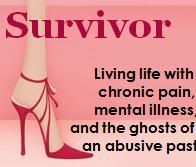This post was inspired by Mama Kat’s Writer’s Workshop.

When I saw the five choices for this week’s assignment I didn’t hesitate as to which one I would pick. I actually wrote to Oprah a few years ago asking her to have someone on her show who has more courage and a greater voice than I do, Christine Miserandino, who formed the But You Don’t Look Sick website seven years ago.
Christine’s website is a haven for people who suffer from Invisible Illnesses, and about 96% of all illnesses are invisible, so very sick people can look perfectly fine when seen by healthy people.
So, here I am on the Oprah Winfrey Show (which I don’t watch, so I am ad-libbing the format):
Oprah: So Emily, tell me about your reason for coming here today.
Emily: My purpose is to educate people about Invisible Illnesses and the people that suffer with them.
Oprah: What is an Invisible Illness?
Emily: Simply, put it’s any disease, illness or chronic condition that can’t be seen when you look at a person. A lot of people can “fake it” by putting on make-up, nice clothes and doing their hair, and they don’t look sick at all. I have Lupus, Fibromyalgia, Chronic Fatigue Syndrome, and Chronic Myofascial Pain, to name a few.
Oprah: Well I know a bit about Lupus and know it can be a very serious disease, but you’re right, you look beautiful, you look healthy.
Emily: Well that’s because one of your stylists did my hair and makeup for me. But I can’t do my hair or makeup and haven’t put on any makeup or done my hair in about a year because that’s too tiring for me. Some days I can’t bathe because it just takes too much energy. I am housebound a lot of time because going out to even run simple errands completely drains me.
Oprah: Wow.
Emily: I also want to tell you and your audience that when people can’t see that some people are sick, they develop prejudices against them and make judgements about them. Often a person’s own family or friends do not believe that their loved one is ill because they are not yet diagnosed, or they are diagnosed but they just don’t believe that they could be that sick. They don’t believe that their friend or family is not only unable to work, but not able to get out of bed.
People also face other challenges. They may have a handicapped placard or license plate and be able to walk, and people in the parking lot openly berate them for taking up a parking space that is meant for a “sick person”. They may get dirty or confused looks from people when they use scooters or wheelchairs because they do not look like they need them.
A lot of people start to gain weight from either being unable to exercise due to chronic pain and fatigue or from certain medications. Then they have to experience the added judgement of people saying, “Well, maybe if you lost some weight, you wouldn’t feel so ill”.
Oprah doesn’t have any advice for me because as far as I know she has never done a topic like this before so she is speechless, except to end the interview.
Oprah: Well, you’ve certainly educated me and a lot of others (audience makes affirmations). How do we find out more?
Emily: Well, one can simply google “Invisible Illnesses” or “Chronic Illnesses” and they will find hundreds of websites where they could educate themselves. It’s important for everyone to learn about, because unfortunately, some day they may find themselves with an Invisible Illness. And if you know someone with Fibromyalgia or someone who is chronically tired or in pain, learn a little bit about how you can help them, and ask them how you can help them.
Oprah: Emily blogs about living with her illness while raising a child on her blog Mama Sick.com. Thank you so much for coming to speak with us today. Coming up, we’ll be talking about fashion “do”s and “don’ts” for the fall.
Enthusiastic audience applause and music, cut to commercial about the latest drug for Erectile Dysfunction.













8 Responses to Going on Oprah…In My Mind!